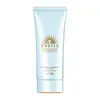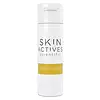What's inside
What's inside
 Key Ingredients
Key Ingredients

 Benefits
Benefits

 Concerns
Concerns

 Ingredients Side-by-side
Ingredients Side-by-side

Water
Skin ConditioningDiisopropyl Sebacate
EmollientCaprylyl Methicone
Skin ConditioningDipropylene Glycol
HumectantButylene Glycol
HumectantGlycerin
HumectantTriethylhexanoin
MaskingZinc Oxide
Cosmetic ColorantTitanium Dioxide
Cosmetic ColorantPentaerythrityl Tetraethylhexanoate
EmollientSilica
AbrasiveBis-Ethylhexyloxyphenol Methoxyphenyl Triazine
Skin ConditioningBis-Butyldimethicone Polyglyceryl-3
CleansingIsostearic Acid
CleansingAcrylamides/Dmapa Acrylates/Methoxy PEG Methacrylate Copolymer
Ethylhexyl Triazone
UV AbsorberDextrin Palmitate/Ethylhexanoate
EmulsifyingDiethylamino Hydroxybenzoyl Hexyl Benzoate
UV FilterPEG/PPG-14/7 Dimethyl Ether
Skin ConditioningPaeonia Albiflora Root Extract
Skin ConditioningDipotassium Glycyrrhizate
HumectantSodium Acetylated Hyaluronate
HumectantHydrated Silica
AbrasivePEG-100 Hydrogenated Castor Oil
EmulsifyingAluminum Hydroxide
EmollientDimethylacrylamide/Sodium Acryloyldimethyltaurate Crosspolymer
Dimethicone
EmollientHydrogen Dimethicone
Succinoglycan
Skin ConditioningCitric Acid
BufferingHydroxypropyl Methylcellulose Stearoxy Ether
Stearic Acid
CleansingDextrin Palmitate
EmulsifyingSodium Citrate
BufferingTocopherol
AntioxidantPhenoxyethanol
PreservativeBenzoic Acid
MaskingWater, Diisopropyl Sebacate, Caprylyl Methicone, Dipropylene Glycol, Butylene Glycol, Glycerin, Triethylhexanoin, Zinc Oxide, Titanium Dioxide, Pentaerythrityl Tetraethylhexanoate, Silica, Bis-Ethylhexyloxyphenol Methoxyphenyl Triazine, Bis-Butyldimethicone Polyglyceryl-3, Isostearic Acid, Acrylamides/Dmapa Acrylates/Methoxy PEG Methacrylate Copolymer, Ethylhexyl Triazone, Dextrin Palmitate/Ethylhexanoate, Diethylamino Hydroxybenzoyl Hexyl Benzoate, PEG/PPG-14/7 Dimethyl Ether, Paeonia Albiflora Root Extract, Dipotassium Glycyrrhizate, Sodium Acetylated Hyaluronate, Hydrated Silica, PEG-100 Hydrogenated Castor Oil, Aluminum Hydroxide, Dimethylacrylamide/Sodium Acryloyldimethyltaurate Crosspolymer, Dimethicone, Hydrogen Dimethicone, Succinoglycan, Citric Acid, Hydroxypropyl Methylcellulose Stearoxy Ether, Stearic Acid, Dextrin Palmitate, Sodium Citrate, Tocopherol, Phenoxyethanol, Benzoic Acid
Ethylhexyl Methoxycinnamate 7.5%
UV AbsorberZinc Oxide 7%
Cosmetic ColorantEthylhexyl Salicylate 5%
UV AbsorberWater
Skin ConditioningGlyceryl Stearate
EmollientPEG-100 Stearate
C12-15 Alkyl Benzoate
AntimicrobialHydrogenated Vegetable Oil
EmollientCetyl Alcohol
EmollientCeteareth-20
CleansingCyclomethicone
EmollientCetyl Dimethicone
EmollientDimethicone
EmollientAscorbic Acid
AntioxidantRetinyl Palmitate
Skin ConditioningTocopheryl Acetate
AntioxidantCamellia Sinensis Leaf Extract
AntimicrobialCitrus Nobilis Peel Extract
MaskingCalendula Officinalis Extract
Skin ConditioningPanax Ginseng Root Extract
EmollientGinkgo Biloba Leaf Extract
Skin ConditioningDipotassium Glycyrrhizate
HumectantHyaluronic Acid
HumectantSodium PCA
HumectantCitric Acid
BufferingXanthan Gum
EmulsifyingTetrasodium EDTA
Methylparaben
PreservativeDiazolidinyl Urea
PreservativeEthylhexyl Methoxycinnamate 7.5%, Zinc Oxide 7%, Ethylhexyl Salicylate 5%, Water, Glyceryl Stearate, PEG-100 Stearate, C12-15 Alkyl Benzoate, Hydrogenated Vegetable Oil, Cetyl Alcohol, Ceteareth-20, Cyclomethicone, Cetyl Dimethicone, Dimethicone, Ascorbic Acid, Retinyl Palmitate, Tocopheryl Acetate, Camellia Sinensis Leaf Extract, Citrus Nobilis Peel Extract, Calendula Officinalis Extract, Panax Ginseng Root Extract, Ginkgo Biloba Leaf Extract, Dipotassium Glycyrrhizate, Hyaluronic Acid, Sodium PCA, Citric Acid, Xanthan Gum, Tetrasodium EDTA, Methylparaben, Diazolidinyl Urea
Ingredients Explained
These ingredients are found in both products.
Ingredients higher up in an ingredient list are typically present in a larger amount.
Citric Acid is an alpha hydroxy acid (AHA) naturally found in citrus fruits like oranges, lemons, and limes.
Like other AHAs, citric acid can exfoliate skin by breaking down the bonds that hold dead skin cells together. This helps reveal smoother and brighter skin underneath.
However, this exfoliating effect only happens at high concentrations (20%) which can be hard to find in cosmetic products.
Due to this, citric acid is usually included in small amounts as a pH adjuster. This helps keep products slightly more acidic and compatible with skin's natural pH.
In skincare formulas, citric acid can:
While it can provide some skin benefits, research shows lactic acid and glycolic acid are generally more effective and less irritating exfoliants.
Most citric acid used in skincare today is made by fermenting sugars (usually from molasses). This synthetic version is identical to the natural citrus form but easier to stabilize and use in formulations.
Read more about some other popular AHA's here:
Learn more about Citric AcidDimethicone is a type of synthetic silicone created from natural materials such as quartz.
What it does:
Dimethicone comes in different viscosities:
Depending on the viscosity, dimethicone has different properties.
Ingredients lists don't always show which type is used, so we recommend reaching out to the brand if you have questions about the viscosity.
This ingredient is unlikely to cause irritation because it does not get absorbed into skin. However, people with silicone allergies should be careful about using this ingredient.
Note: Dimethicone may contribute to pilling. This is because it is not oil or water soluble, so pilling may occur when layered with products. When mixed with heavy oils in a formula, the outcome is also quite greasy.
Learn more about DimethiconeDipotassium Glycyrrhizate comes from licorice root.
Extracts of licorice have demonstrated to have antibacterial, anti‐inflammatory, antiviral, antioxidant properties.
One component, glabridin, has extra potent antioxidant and soothing properties. It has also been found to block pigmentation from UVB rays in guinea pigs.
Licorice Root also contains a flavonoid. Flavonoids are a natural substance from in plants. Flavonoids also have antioxidant properties.
Another component, glycyrrhizin, has been found to have anti-inflammatory and antimicrobial benefits. This may make licorice root extract effective at treating acne. However, more research is needed to support this.
Liquiritin is one of the flavone compounds found in licorice. It has been found to help lighten skin by preventing tyrosinase from reacting with tyrosine. When the two react, protein is converted to melanin. Melanin is the substance in your body that gives your features pigmentation.
Licorice root is native to Southern Europe and Asia. It has been used in traditional Chinese medicine to help with respiratory issues.
Learn more about Dipotassium GlycyrrhizateWater. It's the most common cosmetic ingredient of all. You'll usually see it at the top of ingredient lists, meaning that it makes up the largest part of the product.
So why is it so popular? Water most often acts as a solvent - this means that it helps dissolve other ingredients into the formulation.
You'll also recognize water as that liquid we all need to stay alive. If you see this, drink a glass of water. Stay hydrated!
Learn more about WaterZinc Oxide is a mineral broad-spectrum UV filter; it is the broadest UVA and UVB reflector approved by the FDA. It also has skin protectant and skin soothing properties.
Zinc oxide is one of the most effective broad-spectrum UV filters. It protects against UVB, UVAII, and UVAI. In comparison to its counterpart titanium dioxide, zinc oxide provides uniform and extended UVA protection.
Another great benefit? This ingredient is highly photostable so it won't degrade easily under sunlight.
A common myth is that mineral UV filters are widely believed to primarily reflect UV light.
However, modern research shows titanium dioxide absorbs UV radiation like chemical filters (~95% absorption & 5% reflection).
Zinc oxide has great skin soothing properties so you'll likely find this in sunscreens formulated for sensitive skin or babies/children. It is unlikely to cause "eye sting" like other sunscreen ingredients.
Regulatory agencies consider zinc oxide to be non-toxic and safe. It has also been shown to not penetrate the skin.
Unfortunately, this ingredient does leave a visible white cast. This is why mineral sunscreens are often less cosmetically elegant than chemical or hybrid ones.
In cosmetics, zinc oxide can be found in both non-nano and nano-sized forms. The nano version is used to reduce white cast and improve the texture of sunscreen formulas.
There are ongoing concerns surrounding nano-zinc oxide's impact on marine ecosystems and whether it can be absorbed into skin.
Regarding marine ecosystems and coral reefs, there is no conclusive evidence that any form of zinc oxide (or any other sunscreen ingredients) will cause harm. The science is still developing but many consumers are keeping a close eye on this issue.
Please note, many destinations have reef-safety sunscreen rules. For instance, the U.S. Virgin Islands advises all visitors to use non-nano mineral sunscreens.
There has also been some stir about whether micronized or nano zinc oxide has potential photoxicity and absorption through the skin/lungs.
An in-vitro (done in a test tube or petri dish) study demonstrated micronized zinc oxide to have potential phototoxicity. There's no need to fret; the EU Commission's Scientific Committee on Consumer Safety has stated, "The relevance of these findings needs to be clarified by appropriate investigations in vivo." Or in other words, further studies done on living organisms are needed to prove this.
Current research shows zinc oxide nanoparticles do not penetrate intact or sunburned skin. They either remain on the surface or in the outermost layer of dead skin (stratum corneum).
Zinc oxide is one of only two classified mineral UV filters with titanium dioxide being the other one.
Fun fact: Zinc has been used throughout history as an ingredient in paint and medicine. An Indian text from 500BC is believed to list zinc oxide as a salve for open wound. The Ancient Greek physician Dioscorides has also mentioned the use of zinc as an ointment in 1AD.
Learn more about Zinc Oxide